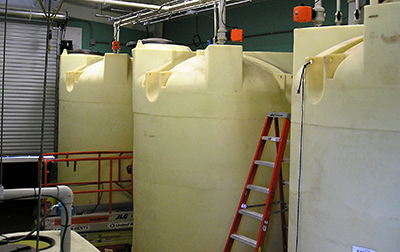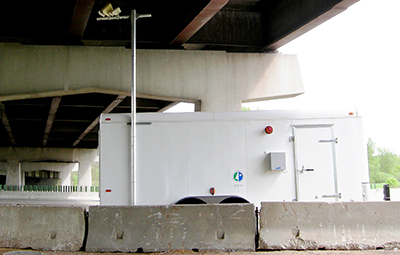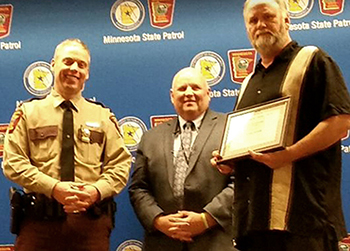 |
|

|
 |
TABLE of CONTENTS
 |
Bridge anti-icing systems work to improve traffic flow, reduce ice-related incidents |
By Judy Jacobs

The three tanks inside the I-35W/St. Anthony Fall pump house each holds 4,000 gallons of chemical for the bridge anti-icing system. Photo by Cal Lucas |
Despite the record warm weather we’ve been experiencing in Minnesota, this winter has been an icy one. From November 2016 through January 2017 almost seven inches of precipitation fell. In January alone there were seven freezing rain events.
With temperatures rising above freezing during the day and then dipping below freezing during the night, the chance for black ice to occur rises, mostly on bridges and overpasses where cold air circulates above and below the surface.
One tool MnDOT uses to combat ice is the automated bridge anti-icing system. MnDOT installed its first one in 1998 on the old Interstate 35W bridge over the Mississippi River. Since then, the technology has seen many improvements, and today, the new I-35W/St Anthony Falls Bridge has the largest fully automated anti-icing system in North America.
MnDOT purchased the first system from a Switzerland-based company, Boschung, which originally developed and sold bridge anti-icing systems. EnvironTech Services, Inc., an industry leader in road solutions based in Colorado, now also supplies MnDOT with bridge anti-icing systems. EnvironTech systems are installed on the Hwy 61 Bridge in Hastings and the I-494/I-169 fly-overs in the Twin Cities.
Technology has advanced anti-icing efforts to a web-based computer program that monitors road conditions and system operations.
“Metro Maintenance works closely with MNIT, which manages the servers,” said Cal Lucas, Metro transportation program specialist 3. “We have our own servers and software so anyone in Metro Maintenance can check on the status of our system or outstate systems.”

The CALDS system trailer is self-contained and can be moved to any bridge to evaluate need for an anti-icing system. Sensors for the system are located on the pole. Photo by Cal Lucas |
Before and during snowfalls, the anti-icing system detects the “grip,” or traction, on the road and determines its safety. If unsafe conditions are identified, the system is activated and a uniform amount of chemical is sprayed onto the road surface before ice can form. This is the reactive system EnvironTech supplies. Boschung systems are preventive in that they use active road sensors and the Road Weather Information System to determine when ice will form and treat the roadway for those conditions. After 10 minutes of consistent snowfall, the road sensors are programmed for chemical application that helps prevent compaction. There are 16 different spray patterns that are used, depending upon storm conditions.
“The system does what computers do best,” said Lucas. “They monitor the roads 24/7/365, and when they sense the road condition is deteriorating, they go to work.”
Currently Metro Maintenance monitors and maintaines eight anti-icing systems. Two more systems are scheduled to be installed before next winter. Bridge anti-icing systems are expensive, upwards of $2 million, so locations for new systems are carefully reviewed to makes sure they are in an area where they can do the most good.
“We evaluate the area using 19 different criteria, such as number of crashes, ADT, roadway design, distance from a MnDOT truck station and shoulder width for snow storage, shadowing - just to name a few,” Lucas said. “Metro Maintenance crews now have a new tool, the CALDS - which stands for Context-Aware Learning from Data Streams - which is a portable, self-contained anti-icing system that we can put in an area for a few years and then evaluate the crash data to see if having the system in that location made a difference.”
Lucas said that MnDOT is working in a partnership with Hennepin County to allow access to Metro District’s anti-icing servers for the county’s anti-icing system on the Lowry Bridge. The city of Bloomington is also consulting with Metro maintenance on the design and construction of the anti-icing system on the new East Bush Lake Road ramp.
“The question I get all the time is, ‘How can the sprayers pop up during a storm and not have the snow plows hit them?'” Lucas said. “At that point I know I have to do a better job of educating. I explain that the nozzle doesn’t pop out of the pavement, but instead the sprayer sprays the chemical 25 feet in a slight angle and then we count on the traffic to do the rest of the work.” |
 |
|

|
 |
TABLE of CONTENTS
 |
Phoenix internship program is accepting applications for 2017 program |
By Rich Kemp

Students participate in Seeds and Phoenix Day June 23 at the Dakota County Rec Center. Photo by David Gonzalez |
The Phoenix Program is accepting applications for the paid internship program for qualified high school students. The program is a partnership between MnDOT and Project Lead The Way, which provides jobs and paid internships for high school students enrolled in pre-engineering courses at area PLTW high schools.
By working at various MnDOT offices and districts statewide, Phoenix Program students gain on-the-job work experience in a variety of areas. The internship is paid and will start in June. Program participants may work up to 15 hours during the school year and 40 hours during summer and school breaks.
“We are looking to get students interested in engineering,” said Jessica Etukudo, Phoenix Program manager. “If MnDOT employees know someone who may be interested, let them know about the program.”
Minimum qualifications are:
- Enrolled at a certified PLTW High School to be considered
- Taking (or have taken) PLTW classes
- Completed junior year and going into senior year of high school
- 3.0 GPA
“By investing in students through on-the-job training, we are helping to ensure highly skilled, well-prepared candidates for future positions within our organization,” said Etukudo.
There are 22 positions this year around the state, representing District 1, District 2, Metro District, District 7 and District 8.
For more information about the program, check out the website or contact Etukudo. |
 |
|

|
 |
TABLE of CONTENTS
 |
SDIC 2.0 classes offered throughout the state |
By Rich Kemp

Hans Bleiker, Institute for Participatory Management & Planning, leads the training during a SDIC 2.0 course Feb. 15 at the University of Minnesota Continuing Education Center. Photo by Richard Davis |
In partnership with Annemarie and Hans Bleiker, Institute for Participatory Management & Planning, MnDOT is now offering a revised course of the systematic development of informed consent. The new SDIC 2.0 course has been combined with the Citizen Participation-by-Objectives training and uses classroom instruction and extensive online learning to educate attendees on how to position government agencies as effective problem solvers.
SDIC is a management strategy designed for aiding in the implementation of potentially controversial projects and programs. The online modules offer course participants considerable time-flexibility – something that classroom learning doesn’t offer. That is what makes it possible to combine the material of both traditional courses into one revamped course.
The target audience includes managers/supervisors, project managers, public affairs coordinators and other employees who are involved in public engagement activities.
“The SDIC course is important to the MnDOT leadership,” said Richard Davis, Public Engagement and Constituent Services director. “The course provides the students with the tools to make them effective as possible when participating in public engagement planning and execution.”
Previous sections of the classes were held in Willmar and St. Paul, with upcoming classes scheduled in Duluth (March 21-22) and St. Cloud (May 16-17).
The course helps participants:
- Understand public-sector problem-solving and decision-making
- Recognize minimum ingredients of public participation
- Become both responsible to the mission and responsive to the public
- Identify the challenges of public involvement
- Understand how torpedoed or gridlocked proposals result in mission-failure
- Achieve 15 citizen participation objectives
For more information about the course, contact Norm Plasch or call 651-366-3301. |
 |
|

|
|

|
|

|
 |
TABLE of CONTENTS
 |
State Patrol recognizes two FIRST drivers for heroic acts |

Marc Gomez, FIRST driver, received a commendation from Col. Matt Langer, chief of the Minnesota State Patrol, Feb. 9 for helping an unresponsive driver on the shoulder of westbound I-694 at Hwy 61. Photo by Jen Longaecker, Department of Public Safety |
Jeff Whalen and Marc Gomez, Freeway Incident Response and Safety Team drivers in the Metro District, received awards from the State Patrol during a ceremony Feb. 9 to honor heroic acts in 2016.
Department of Public Safety Commissioner Mona Dohman and Col. Matt Langer, chief of the Minnesota State Patrol, honored state troopers, citizens and members of other law enforcement and emergency service agencies during the ceremony in Vadnais Heights.
“Everyone in this room would say, ‘I just did what anyone would do.’ But the fact is that’s not true. You did more than what just anyone would do,” Langer said.
The Minnesota State Patrol established its awards ceremony to honor the exemplary efforts of troopers who have excelled in their mission to protect and serve the people of Minnesota. The ceremony also recognizes citizens and members of other law enforcement and emergency service agencies who performed commendable acts to assist troopers and help others.
Whalen and Gomez received the Minnesota State Patrol Commendation Award, which is presented to members of another law enforcement or emergency service agency who have assisted the State Patrol in providing a significant service.

Jeff Whalen, FIRST driver, received a commendation from Col. Matt Langer, chief of the Minnesota State Patrol, and Dave Boden, president of Hiway Federal Credit Union, for efforts in helping an unconscious driver on the shoulder of I-694 in Maple Grove. Photo courtesy of Whalenís Facebook page |
Whalen was on routine patrol as a FIRST driver on May 5 when he came upon a stalled vehicle on the shoulder of Interstate 694 in Maple Grove. The driver was unconscious but had a pulse and was breathing, so Whalen gave him a sternum rub and kept him conscious until an ambulance arrived. It was later determined he had overdosed on prescription pills. The trooper who nominated Whalen said that if he had not stopped to check on the stalled vehicle she was certain the driver would have died in the vehicle.
“I am not a person that wants the spot light and attention,” said Whalen. “I did what any of our FIRST drivers would do. I just happened to be at the right place at the right time. I was glad he was going to be okay and make it home to his family.”
Gomez was on duty Oct. 25 when he came upon a vehicle stalled on the shoulder of westbound I-694 at Hwy 61. The driver was unresponsive. Gomez checked for and found a pulse, but after approximately one minute noticed it was gone. He immediately hooked up his defibrillator and began CPR. As he continued to provide CPR, the ambulance arrived on scene and paramedics took over. |
 |
|

|
 |
TABLE of CONTENTS
 |
Derrick Dasenbrock recognized as an ASCE Fellow |

Derrick Dasenbrock was elected as an ASCE Fellow. Photo courtesy of the Office of Materials and Road Research |
The American Society of Civil Engineers recently elected Derrick Dasenbrock, Office of Materials and Road Reserch, as an ASCE Fellow.
It is a honor held by fewer than 3.5 percent of ASCE members. Fellow status must be attained by professional accomplishments via application and election by the Membership Application Review Committee
As part of the nomination process, Dasenbrock received references from two current Fellows and one ASCE member. Included in his application were 35 tech papers that he has authored and that he has done adjunct teaching at the University of Minnesota.
“It is an honor to be recognized by my peers in the civil engineering profession.” said Dasenbrock, who works in the office's geomechanics section. “It is especially humbling to see my name among the other current and past ASCE Fellow recipients, all of whom have very impressive resumes and accomplishments to their credit.”
|
 |
|
| |
|



